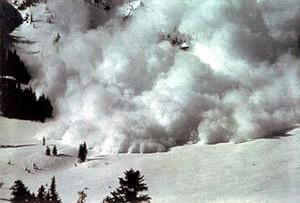AvalanchesNew avalanche, snow burial practice guidelines
With the growing popularity of backcountry snow activities, it is increasingly important to understand the best techniques for avalanche rescue. Each year, there are over 150 avalanche fatalities in the US and Europe, with most deaths occurring among recreational groups that include skiers, snowboarders, snowmobilers, and mountaineers. The Wilderness Medical Society has issued new practice guidelines to help medical professionals, as well as the public, understand the latest techniques and recommendations for avalanche risk management and rescue protocols.

Avalanche bearing down on grown trees // Source: nps.gov
With the growing popularity of backcountry snow activities, it is increasingly important to understand the best techniques for avalanche rescue. Each year, there are over 150 avalanche fatalities in the US and Europe, with most deaths occurring among recreational groups that include skiers, snowboarders, snowmobilers, and mountaineers. The Wilderness Medical Society has issued new practice guidelines to help medical professionals, as well as the public, understand the latest techniques and recommendations for avalanche risk management and rescue protocols. These guidelines are published in the March issue of Wilderness & Environmental Medicine.
Elsevier says that to create the guidelines, an expert panel was assembled and led by Christopher Van Tilburg, MD, a physician at Providence Hood River Memorial Hospital in the Occupational and Travel Medicine, Emergency, and the Mountain Clinic departments and a Fellow of the Academy of Wilderness Medicine. The panel focused exclusively on developing evidence-based recommendations for three main aspects of avalanche and snow burial accidents: prevention, rescue, and resuscitation. “Orchestrating eleven authors from four countries was extremely rewarding and challenging,” commented Dr. Van Tilburg. “We had collegial, enlightening, and good-natured discussions via email on seven drafts of the article.”
An avalanche accident presents a unique set of challenges for rescue workers. Asphyxia is the most common cause of mortality in avalanche victims, accounting for 75% of deaths. Asphyxiation can occur via three main mechanisms: inhaled snow or other debris blocks an airway; water vapor from expelled air freezes and forms an ice mask around the face; or oxygen deprivation caused by having to rebreathe expired air. Because of the dangers of asphyxiation, time plays a crucial role in survival rates. If completely buried, a victim has a greater than 90 percent survival rate if they are found and extricated within about 15 minutes, but only a 30% survival rate if the rescue time stretches to thirty minutes. In addition, many avalanche victims suffer life-threatening injuries during their avalanche involvement. Data from the US and Europe indicate that trauma is the primary cause of death for approximately 25 percent of avalanche fatalities.
